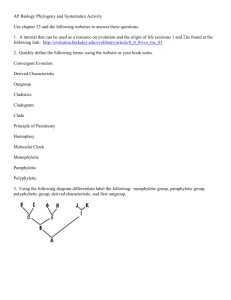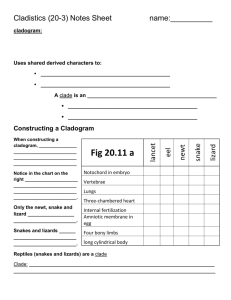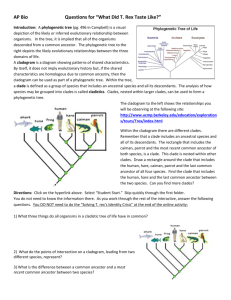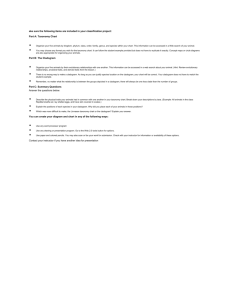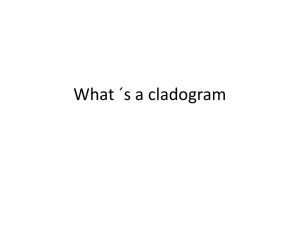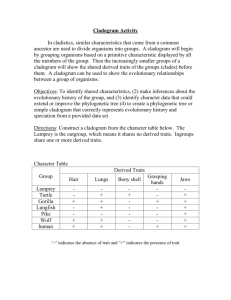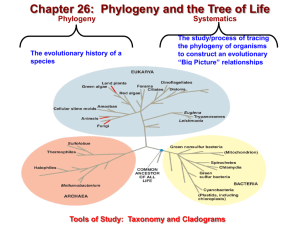Classification and Phylogeny
advertisement
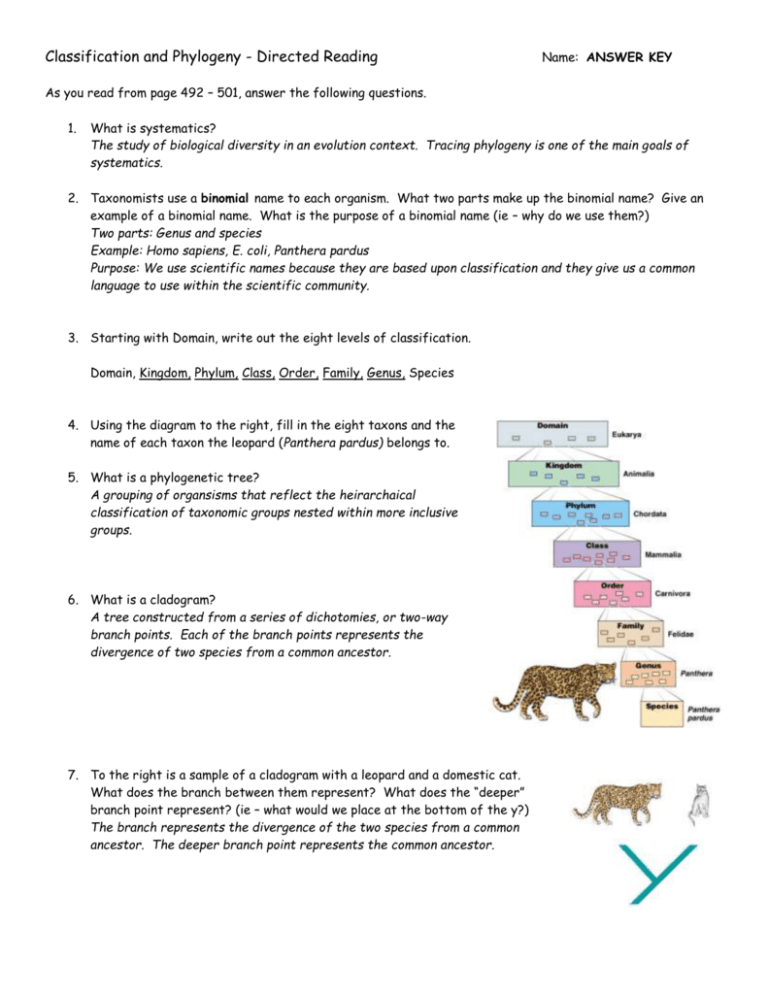
Classification and Phylogeny - Directed Reading Name: ANSWER KEY As you read from page 492 – 501, answer the following questions. 1. What is systematics? The study of biological diversity in an evolution context. Tracing phylogeny is one of the main goals of systematics. 2. Taxonomists use a binomial name to each organism. What two parts make up the binomial name? Give an example of a binomial name. What is the purpose of a binomial name (ie – why do we use them?) Two parts: Genus and species Example: Homo sapiens, E. coli, Panthera pardus Purpose: We use scientific names because they are based upon classification and they give us a common language to use within the scientific community. 3. Starting with Domain, write out the eight levels of classification. Domain, Kingdom, Phylum, Class, Order, Family, Genus, Species 4. Using the diagram to the right, fill in the eight taxons and the name of each taxon the leopard (Panthera pardus) belongs to. 5. What is a phylogenetic tree? A grouping of organsisms that reflect the heirarchaical classification of taxonomic groups nested within more inclusive groups. 6. What is a cladogram? A tree constructed from a series of dichotomies, or two-way branch points. Each of the branch points represents the divergence of two species from a common ancestor. 7. To the right is a sample of a cladogram with a leopard and a domestic cat. What does the branch between them represent? What does the “deeper” branch point represent? (ie – what would we place at the bottom of the y?) The branch represents the divergence of the two species from a common ancestor. The deeper branch point represents the common ancestor. 8. What do each of the following groupings on the cladogram represent? Monophyletic – A clade containing an ancestral species and all of its decendants. Paraphyletic – An ancestor and some of its descendants. Polyphyletic – A taxon that does not contain a common ancestor. 9. Define a. homology – a likeness due to a shared ancestry, EX: forelimbs of mammals b. analogy – a likeness due to convergent evolution EX: wings on bats and birds 10. How can we determine the difference between homology and analogy? The greater the number of homologous parts, the more closely the species are related. The more complex two structure are, the less likely they evolved independently EX: the skull of a chimpanzee and a human 11. Scientists must also determine if a characteristic is a shared primitive characteristic or a shared derived characterisitic. For example, lets look at the presence of a backbone. We can not use just the presence of a backbone to identify and distinguish mammals since fish and reptile also have backbones. Therefore, the backbone is a homology that came before the branching of the mammalian clade from the vertebrate tree and is a shared primitive characteristic. It is common to a taxon that is more inclusive (larger) than the one we are looking at. In contrast, hair is a homology found only in the vertebrates called mammals. If we compare mammals to other vertebrates, hair is a shared derived characteristic. This tells us it is an evolutionary novelty unique to a particular clade. Fill in the flow chart below that summarizes our findings. Analogies All similar characters Primitive (ancestral) Homologies Derived (unique to a clade) 12. In order to construct a cladogram, scientists will compare the organism they are relating with an outgroup. What is an outgroup and why is it used? An outgroup is a species or group of species that is closely related to the species being studies, but is known to be less closely related than any of the study-group members are to each other. This is based on evidence from paleontology, embryonic development, and molecular biology. 13. Using the example given on page 497, fill in the character table and cladogram given below. 14. What does a cladogram represent? A cladogram represents the chronological sequence of branching during the evolutionary history of a set of organisms. 15. True of False: The turtle in question 13 has evolved more recently than the salamander. If you choose false correct this statement. FALSE: It means that the common ancestor of the salamander preceded the ancestor of the turtle-leopard clade. Chronology in a cladogram is relative rather than absolute. 16. Cladograms can be used to place species in the taxonomic hierarchy of groups within groups. Using the diagram to the right, label the nested circles with the taxa they represent. House cat and Leopard: Family Wolf, Leopard, and House cat: Order Horse, Wolf, Leopard, and House cat: Class 17. Up to this point, we’ve based out cladograms on physical characteristics. What other piece of evidence could be used to construct a cladogram? DNA sequences 18. What does the principle of parsimony tell us? A theory about nature should be the simplest explanation that is consistent with the facts. IE – “keep it simple”. Parsimony is sometimes called Occam’s Razor. 19. Use the data and charts on pages 500 – 501. Based on the three hypothesized cladograms of bird species below, which is the best representation of evolutionary relationships between the species? Why do we come to this conclusion? Based upon the data give in the textbook, The first (or left) cladogram drawn above is the most correct. When using the DNA sequence data in the table to the left, it becomes clear after some analysis that the least number of evolutionary events would occur with the first hypothesized cladogram. Keeping with parsimony, the least number of evolutionary events is the most simplest explanation and therefore, most likely the best answer.


